I have successfully detected bounding boxes, now I want to remove everything else in the image and just remain with the content of the bounding boxes to improve on tesseract accuracy, below is an image representation of what I have done and need (I want the binary images to only contain the letters, all the other objects to be removed):

and my code:
public static ProcessedFrame preProcessImage(Mat image){
originalFrame = image.clone();
roiColor = image.clone();
Imgproc.cvtColor(image, image, Imgproc.COLOR_BGR2GRAY, 0);
originalFrameGrayScale = image.clone();
Mat morph = Imgproc.getStructuringElement(Imgproc.MORPH_RECT, new Size(9, 9));
Imgproc.morphologyEx(image, image, Imgproc.MORPH_TOPHAT, morph);
Imgproc.Sobel(image, image, -1, 2, 0);
Imgproc.GaussianBlur(image, image, new Size(5,5), 3,3);
Imgproc.morphologyEx(image, image, Imgproc.MORPH_CLOSE, morph);
Imgproc.threshold(image, image, 200, 255, Imgproc.THRESH_OTSU);
Vector<Rect> rectangles = detectionContour(image);
Mat roi = originalFrameGrayScale.clone();
if(!rectangles.isEmpty()){
roi = originalFrameGrayScale.submat(rectangles.get(0));
roiBlack = roi.clone();
roiColor = roiColor.submat(rectangles.get(0));
Imgproc.rectangle(originalFrame, rectangles.get(0).br(), rectangles.get(0).tl(), new Scalar(0,0,255), 2);
}
Imgproc.medianBlur(roi, roi, 3);
Imgproc.adaptiveThreshold(roi, roi, 225, Imgproc.ADAPTIVE_THRESH_GAUSSIAN_C, Imgproc.THRESH_BINARY, 15, 3);
Imgproc.medianBlur(roi, roi, 3);
Imgproc.medianBlur(roi, roi, 3);
Imgproc.adaptiveThreshold(roi, roi, 225, Imgproc.ADAPTIVE_THRESH_GAUSSIAN_C, Imgproc.THRESH_BINARY, 15, 3);
Imgproc.medianBlur(roi, roi, 3);
roiBinarize = roi.clone();
Mat erode = Imgproc.getStructuringElement(Imgproc.MORPH_RECT, new Size(3, 3));
Mat dilate = Imgproc.getStructuringElement(Imgproc.MORPH_RECT,new Size(3, 3));
Imgproc.morphologyEx(roi, roi, Imgproc.MORPH_CLOSE, dilate);
Imgproc.morphologyEx(roi, roi, Imgproc.MORPH_CLOSE, erode);
Vector<Rect> letters = detectionPlateCharacterContour(roi);
doTesseractOCR(letters, roiBinarize);
return new ProcessedFrame(originalFrame, roiColor, roiBinarize, roi);
}
private static void doTesseractOCR(Vector<Rect> letters, Mat plate){
Tesseract instance = new Tesseract(); //
instance.setLanguage(LANGUAGE);
String resultPlate = "AAA0000";
for(int i= 0; i < letters.size(); i++){
BufferedImage letter = OpenCvUtils.Mat2bufferedImage(plate.submat(letters.get(i)));
try {
String result = instance.doOCR(letter);
String character = result.replace("\n", "");
resultPlate = new StringBuilder(resultPlate).replace(i ,i+1, character).toString();
} catch (TesseractException e) {
System.err.println(e.getMessage());
}
System.out.println("Tesseract output: "+resultPlate);
}
try {
String result = instance.doOCR(OpenCvUtils.Mat2bufferedImage(roiBinarize));
System.out.println("Tesseract output2: "+result.replace("\n", ""));
} catch (TesseractException e) {
System.err.println(e.getMessage());
}
}
private static Vector<Rect> detectionPlateCharacterContour(Mat roi) {
Mat contHierarchy = new Mat();
Mat imageMat = roi.clone();
Rect rect = null;
List<MatOfPoint> contours = new ArrayList<>();
Imgproc.findContours(imageMat, contours, contHierarchy, Imgproc.RETR_CCOMP, Imgproc.CHAIN_APPROX_SIMPLE);
Vector<Rect> rect_array = new Vector<>();
for (int i = 0; i < contours.size(); i++) {
rect = Imgproc.boundingRect(contours.get(i));
double ratio = 0;
if(rect.height > rect.width){
ratio = rect.height/rect.width;
}else{
ratio = rect.width/rect.height;
}
Logger.printMessage("Ratio of letter: "+ratio);
double contourarea = Imgproc.contourArea(contours.get(i));
if (contourarea >= 160 && contourarea <= 1000 && ( ratio >= 1 && ratio <= 2)) {
Imgproc.rectangle(roiColor, rect.br(), rect.tl(), new Scalar(10,50,255));
rect_array.add(rect);
}
}
contHierarchy.release();
return rect_array;
}
private static Vector<Rect> detectionContour(Mat outmat) {
Mat contHierarchy = new Mat();
Mat imageMat = outmat.clone();
List<MatOfPoint> contours = new ArrayList<>();
Imgproc.findContours(imageMat, contours, contHierarchy, Imgproc.RETR_EXTERNAL, Imgproc.CHAIN_APPROX_NONE);
Vector<Rect> rect_array = new Vector<>();
for (int i = 0; i < contours.size(); i++) {
Rect rect = Imgproc.boundingRect(contours.get(i));
Mat contour = contours.get(i);
double contourarea = Imgproc.contourArea(contour);
double ratio = 0;
int radius = 0;
if(rect.height > rect.width){
ratio = rect.height/rect.width;
radius = rect.height/2;
}else{
ratio = rect.width/rect.height;
radius = rect.width/2;
}
if (contourarea >= 2000 && contourarea <= 10000 && ( ratio == 1 || ratio == 2)) {
Logger.printMessage("Rectangle ratio: "+ratio);
MatOfPoint2f mat2f = new MatOfPoint2f();
contours.get(i).convertTo(mat2f, CvType.CV_32FC2);
RotatedRect rotatedRect = Imgproc.minAreaRect( mat2f );
double rotationAngle = rotatedRect.angle;
if(rotatedRect.angle > 0)
rotationAngle = 90 - rotatedRect.angle;
else
rotationAngle = rotatedRect.angle;
Logger.printMessage("Rotation is: "+(rotationAngle));
rect = enlargeROI(originalFrame, rect, 10);
rect_array.add(rect);
}
}
contHierarchy.release();
return rect_array;
}
private Vector<Rect> detectionContours(Mat outmat) {
Mat contHierarchy = new Mat();
Mat imageMat = outmat.clone();
Rect contourRect = null;
List<MatOfPoint> contours = new ArrayList<>();
Imgproc.findContours(imageMat, contours, contHierarchy, Imgproc.RETR_LIST, Imgproc.CHAIN_APPROX_SIMPLE);
Vector<Rect> rect_array = new Vector<>();
for (int i = 0; i < contours.size(); i++) {
Mat contour = contours.get(i);
double contourarea = Imgproc.contourArea(contour);
if (contourarea > minBlob && contourarea < maxBlob) {
contourRect = Imgproc.boundingRect(contours.get(i));
rect_array.add(contourRect);
}
}
contHierarchy.release();
return rect_array;
}
When i run this code printing out the centroid of each rectangle i find that 2 x: 18.0 y: 111.0 2 x: 42.0 y:109.0 7 x: 65.0 y: 108.0 0x:89.0 y: 108.0 A x: 29.0 y: 61.0 C x: 52.0 y: 58.0 P x: 77.0 y: 58.0
